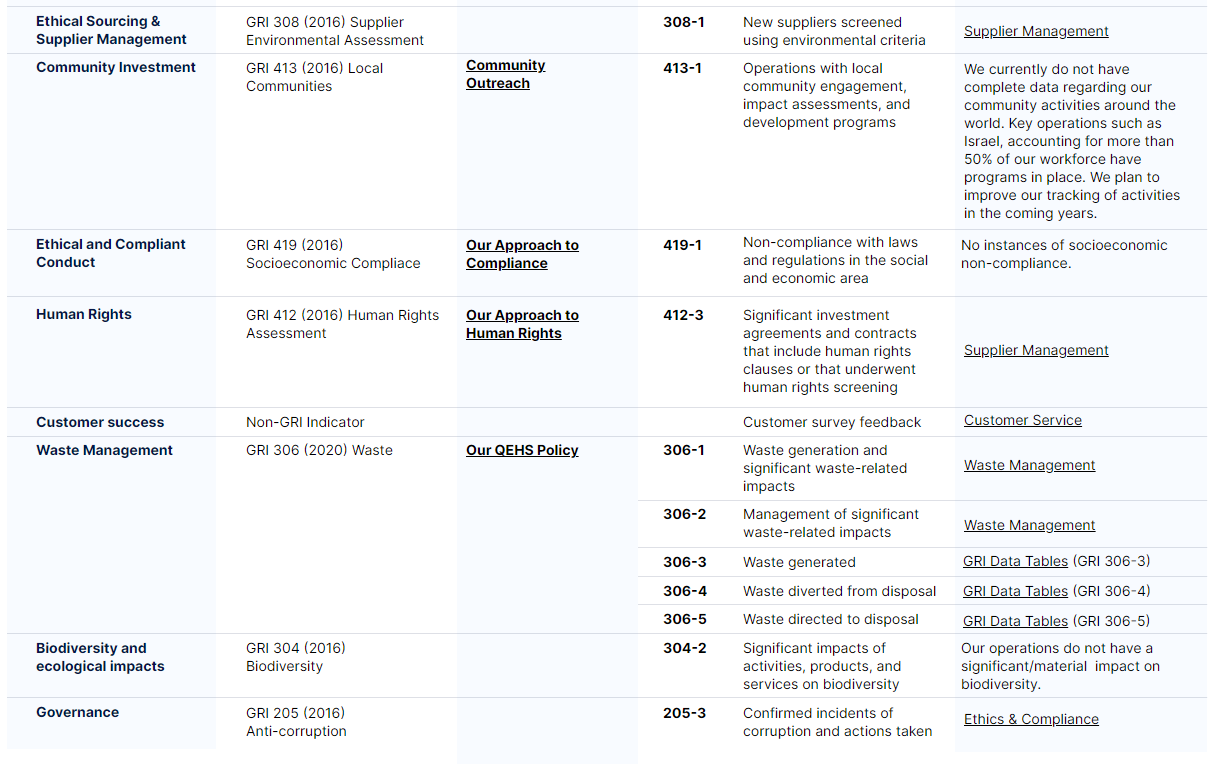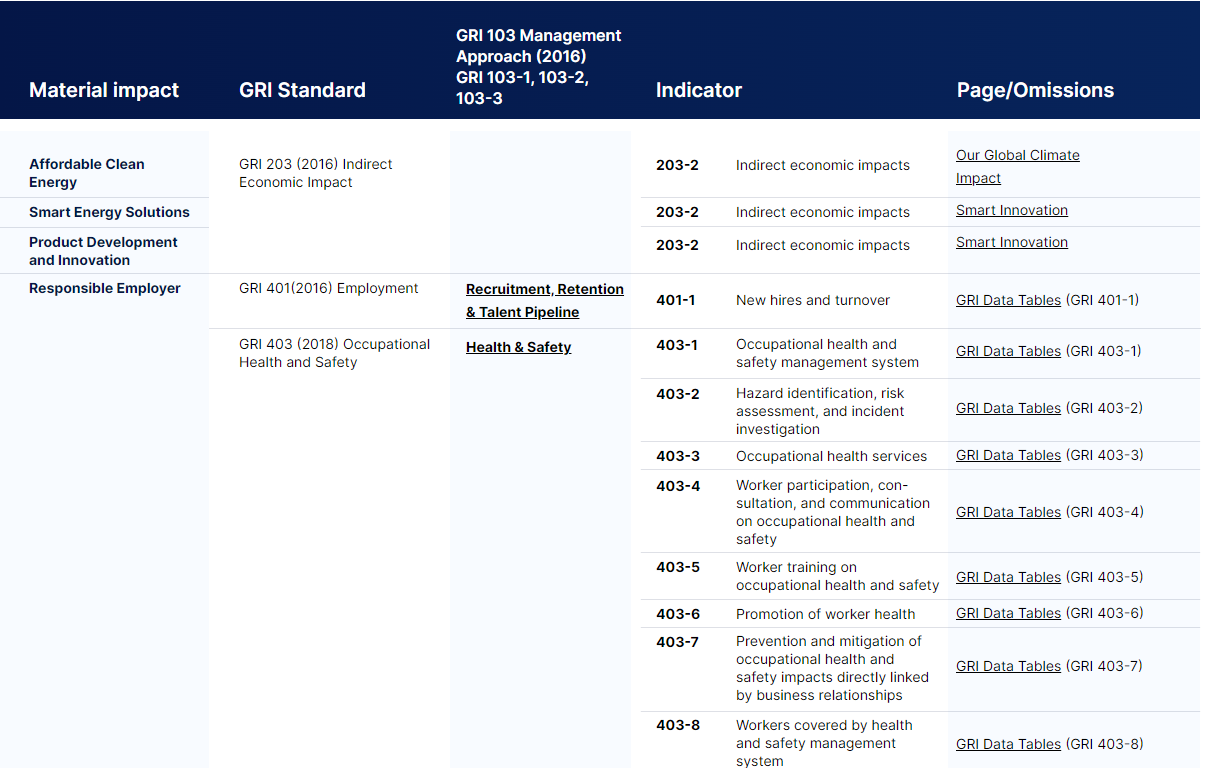Sustainability Strategy & Performance
Sustainability Strategy & Performance
Sustainability Strategy & Performance
Sustainability Strategy & Performance
Sustainability Strategy & Performance
Sustainability Strategy & Performance
GRI Data Tables (GRI 305-2: GRI 305-4; GRI 403-9)
GRI Data Tables (GRI 102-8)
2024 Annual Meeting and Proxy Statement (P. 62)
2024 Annual Meeting and Proxy Statement (P. 46-47, 49 & 54-55)
2024 Annual Meeting and Proxy Statement (P. 47-48 & 60-61)
2024 Annual Meeting and Proxy Statement (P. 20-21)
2024 Annual Meeting and Proxy Statement (P. 13)
2024 Annual Meeting and Proxy Statement (P. 17)
2024 Annual Meeting and Proxy Statement (P. 5)
2024 Annual Meeting and Proxy Statement (P. 6-11, 19-22)
GRI Data Tables (GRI 102-41)
GRI Data Tables (GRI 102-43)
Powering the World through Positive Policy
Ethics & Compliance
Ethics & Compliance
Ethics & Compliance
Powering People- entire chapter ; GRI Data Tables (GRI 102-8)
Company Profile
Company Profile
About This Report
About This Report
About This Report
SolarEdge Technologies Ltd has reported the information cited in this GRI content index for the period January 1st to December 31st 2023 with reference to the GRI Standards.
GRI 1: Foundation 1
1
Management of material topics
List of material topics
Embedding policy commitments
Communication of critical concerns
Workers who are not employees
Membership associations
Process to determine remuneration
Role of the highest governance body in overseeing the management of impacts
Restatements of information
Collective bargaining agreements
Statement on sustainable development strategy
Role of the highest governance body in sustainability reporting
Activities, value chain and other business relationships
Mechanisms for seeking advice and raising concerns
Evaluation of the performance of the highest governance body
Sustainability Governance
Sustainability Governance
Sustainability Governance
Sustainability Governance
Nomination and selection of the highest governance body
Entities included in the organization’s sustainability reporting
Process to determine material topics
Policy commitments
Conflicts of interest
Employees
Compliance with laws and regulations
Remuneration policies
Chair of the highest governance body
Reporting period, frequency and contact point
Approach to stakeholder engagement
Annual total compensation ratio
Delegation of responsibility for managing impacts
External assurance
Processes to remediate negative impacts
Collective knowledge of the highest governance body
Governance structure and composition
Organizational details
3-3
3-2
2-24
2-16
2-8
2-28
2-20
2-12
2-4
2-30
2-22
2-14
2-26
2-18
2-10
2-2
3-1
2-23
2-15
2-7
2-27
2-19
2-11
2-3
2-29
2-21
2-13
2-5
2-25
2-17
2-9
2-1
Page reference or response
Description
Reference
GRI 1: Foundation 2021
GRI 2: General Disclosures 2021
GRI 3: Material Topics 2021
2-6
Training & Development
Lifecycle Assessment
Ethics & Compliance
Waste Management
Waste Management
Customer Service
Supplier Management
Supplier Management
GRI Data Tables (GRI 306-5)
GRI Data Tables (GRI 306-4)
GRI Data Tables (GRI 306-3)
GRI Data Tables (GRI 303-5)
GRI Data Tables (GRI 303-4)
GRI Data Tables (GRI 303-3)
GRI Data Tables (GRI 302-3)
GRI Data Tables (GRI 302-1)
GRI Data Tables (GRI 305-4)
GRI Data Tables (GRI 305-3)
GRI Data Tables (GRI 305-2)
GRI Data Tables (GRI 305-1)
GRI Data Tables (GRI 405-1)
GRI Data Tables (GRI 404-3)
GRI Data Tables (GRI 404-1)
GRI Data Tables (GRI 403-10)
GRI Data Tables (GRI 403-9)
GRI Data Tables (GRI 403-8)
GRI Data Tables (GRI 403-7)
GRI Data Tables (GRI 403-6)
GRI Data Tables (GRI 403-5)
GRI Data Tables (GRI 403-4)
GRI Data Tables (GRI 403-3)
GRI Data Tables (GRI 403-2)
GRI Data Tables (GRI 403-1)
GRI Data Tables (GRI 401-1)
Smart Innovation
Smart Innovation
Our Global Climate Impact
Our Approach to Human Rights
Our Approach to Compliance
305-3
305-2
305-1
403-5
403-8
403-7
403-4
404-3
405-1
404-2
403-2
403-1
403-3
404-1
403-10
302-1
303-2
303-1
302-3
306-2
304-2
306-1
412-3
GRI 412 (2016) Human Rights Assessment
Human Rights
419-1
413-1
205-3
308-1
306-5
306-4
306-3
303-5
303-4
303-3
305-4
403-9
403-6
401-1
203-2
Workers covered by health and safety management system
Other indirect (Scope 3) GHG emissions
Energy indirect (Scope 2) GHG emissions
Direct (Scope 1) GHG emissions
Worker training on occupational health and safety
Prevention and mitigation of occupational health and safety impacts directly linked by business relationships
Worker participation, con-sultation, and communication on occupational health and safety
Percentage of employees receiving regular performance and career development reviews
Diversity of governance bodies and employees
Programs for upgrading employee skills and transition assistance programs
Hazard identification, risk assessment, and incident investigation
Occupational health and safety management system
Occupational health services
Data by gender/category not available
Average training hours
Work-related ill health
Energy consumption within the organization
Management of significant waste-related impacts
Our operations do not have a significant/material impact on biodiversity.
Significant impacts of activities, products, and services on biodiversity
Waste generation and significant waste-related impacts
Customer survey feedback
LCA value of PV Inverters
Management of water discharge-related impacts
Interactions with water as a shared resource
Energy intensity
We currently do not have complete data regarding our community activities around the world. Key operations such as Israel, accounting for more than 50% of our workforce have programs in place. We plan to improve our tracking of activities in the coming years.
No instances of socioeconomic non-compliance.
Significant investment agreements and contracts that include human rights clauses or that underwent human rights screening
Operations with local community engagement, impact assessments, and development programs
Confirmed incidents of corruption and actions taken
Non-compliance with laws and regulations in the social and economic area
New suppliers screened using environmental criteria
Waste directed to disposal
Waste diverted from disposal
Waste generated
Water consumption
Water discharge
Water withdrawal
GHG emissions intensity
Work-related injuries
Promotion of worker health
New hires and turnover
Indirect economic impacts
203-2
Indirect economic impacts
203-2
Indirect economic impacts
Page/Omissions
Indicator
GRI 419 (2016) Socioeconomic Compliace
GRI 413 (2016) Local Communities
GRI 205 (2016)
Anti-corruption
GRI 308 (2016) Supplier Environmental Assessment
GRI 303 (2018)
Water and Effluents
GRI 302 (2016) Energy
GRI 304 (2016)
Biodiversity
GRI 306 (2020) Waste
Non-GRI Indicator
Non-GRI Indicator
GRI 305 (2016) Emissions
GRI 405 (2016) Diversity
and Equal Opportunity
GRI 404 (2016) Training
and Education
GRI 403 (2018) Occupational Health and Safety
GRI 401(2016) Employment
GRI 203 (2016) Indirect Economic Impact
Product Development and Innovation
Ethical and Compliant Conduct
Community Investment
Governance
Ethical Sourcing & Supplier Management
Resource Efficiency
Biodiversity and ecological impacts
Waste Management
Customer success
Product Sustainability
Climate Resilience
Responsible Employer
Smart Energy Solutions
Affordable Clean Energy
GRI 103 Management Approach (2016)
GRI 103-1, 103-2,
103-3
GRI Standard
Material impact
GRI Material Disclosures
Sustainability Report 2023 /
GRI Content Index
Join the SolarEdge Conversation
Contact our sustainability / ESG team
Contact us
How can we help you?
*Slide to the left to see entire table
*Slide to the left to see entire table
Join the SolarEdge Conversation
Contact our sustainability / ESG team
Contact us
How can we help you?
GRI Material Disclosures
GRI 1: Foundation 2021
GRI 2: General Disclosures 2021
GRI 3: Material Topics 2021















